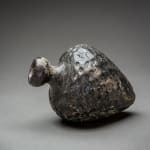Sphero-Conical Glass Vessel, 900 BCE - 1100 CE
Glass
10.4 x 7.6 cm
4 1/8 x 3 in
4 1/8 x 3 in
LO.891
Small sphero-conical glass container with signs of weathering and iridiescent patina. Small bulging mouth and narrow neck. The number of extant sphero-conical vessels in glass is limited and represents only...
Small sphero-conical glass container with signs of weathering and iridiescent patina. Small bulging mouth and narrow neck.
The number of extant sphero-conical vessels in glass is limited and represents only a fraction of those made of stone and ceramic. In general they distinguish themselves for their thinner and more delicate profile, hence excluding a use as containers for quicksilver or for long distance transports.
The identification as container of fuqqa seems likely: glass is less porous than pottery and thus the fermented liquid would have lasted longer and its odour would have not permeated the interior through prolongued repetitive use.
The bulged opening of the vessel is typical of the majority of sphero-conical vessels and was probably meant for slowly drinking the fermented liquid.
The chronological period for the production of these containers would range from the 10th to the early 14th century. Without doubt the area of origin would be the Iranian region, though the existence of enamelled and gilded objects proves that the type was adopted by the Ayyubids and early Mamluk of Syria and Egypt.These 'gourds' were made for important personalities at the Mamluk court and given away as diplomatic presents. They probably symbolised courtly past-times and libation activities, connected with the drinking of fuqqa or other intoxicaitng drinks. For related works see:
Stefano Carboni, Glass from the Islamic Lands, London 2001: Cat.53b, p.213. Sphero-conical vessel, mould-blown dark green glass with tooled decoration; it has a heart-shaped body decorated with cut honeycomb patterns, short neck which opens up and terminates in a rolled rim. Iran, 10th – 11th century.
Ht. 10.4cm; Top diam. 2.5cm.
Comparative material: Carboni, cat.no.3b, inv.no. LNS 1064 G, pp.211, 213. Prof. Geza Fehervar Prof. Geoffrey Kin
The number of extant sphero-conical vessels in glass is limited and represents only a fraction of those made of stone and ceramic. In general they distinguish themselves for their thinner and more delicate profile, hence excluding a use as containers for quicksilver or for long distance transports.
The identification as container of fuqqa seems likely: glass is less porous than pottery and thus the fermented liquid would have lasted longer and its odour would have not permeated the interior through prolongued repetitive use.
The bulged opening of the vessel is typical of the majority of sphero-conical vessels and was probably meant for slowly drinking the fermented liquid.
The chronological period for the production of these containers would range from the 10th to the early 14th century. Without doubt the area of origin would be the Iranian region, though the existence of enamelled and gilded objects proves that the type was adopted by the Ayyubids and early Mamluk of Syria and Egypt.These 'gourds' were made for important personalities at the Mamluk court and given away as diplomatic presents. They probably symbolised courtly past-times and libation activities, connected with the drinking of fuqqa or other intoxicaitng drinks. For related works see:
Stefano Carboni, Glass from the Islamic Lands, London 2001: Cat.53b, p.213. Sphero-conical vessel, mould-blown dark green glass with tooled decoration; it has a heart-shaped body decorated with cut honeycomb patterns, short neck which opens up and terminates in a rolled rim. Iran, 10th – 11th century.
Ht. 10.4cm; Top diam. 2.5cm.
Comparative material: Carboni, cat.no.3b, inv.no. LNS 1064 G, pp.211, 213. Prof. Geza Fehervar Prof. Geoffrey Kin
1
of
31



